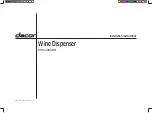
13
Copyright © Puretec Pty Ltd 2020
Reverse Osmosis User Guide
When all of the connections have been made, use the locking bar to hold the fittings in position.
Match the symbols on the locking bar to the corresponding symbols on the manifold (Figure 11).
Step 6: System Startup
1.
Inspect all connections.
2. Position manifold horizontal with openings facing up.
3.
Remove new membrane elements from plastic packaging.
The black and yellow tapes surrounding the membrane are an important
part of the membrane element and should not be removed.
Caution
: Elements contain a food grade preservative. The use of sterile/latex gloves is
recommended.
4. Lubricate all O-ring seats in the manifold that come in contact with the sump and
element O-rings. Refer to “Connection Lubrication” on page 8.
Note
: To properly lubricate the O-ring contact area, a film of clean silicone grease is applied.
The film should cover all of the surface area that the O-ring will slide over and seal with. Do not
use grease containing petroleum products.
5. Securely insert O-ring end of membrane elements into manifold.
6.
Remove prefilter from packaging. Check that gaskets are in place.
7.
Place prefilter in manifold.
8.
Replace sumps and tighten until it bottoms out.
Pressure Test System
To check for leaks, the system must be filled with water and brought up to operating pressure.
1. Open cold water feed valve slowly. Run at 1/2 open for a minute, then open fully.
2. Open faucet until water runs.
3.
Check for leaks.
Note
: When the faucet is initially turned on, water may temporarily sputter from the air gap
until the air is purged. Allow 1 to 3 hours for any trapped air noise in the system to subside.
4. Purge the system. Open the faucet and run the water through the RO system for two
to eight hours.
Note
: A minimum of 2 hour flush is required to remove the food grade preservative. After 8
hours performance will reach its stable maximum performance.
The RO system is now ready for use.
Installation Guide
The table below shows the coding system for the fitting connections.
Each fitting has a unique “keyed” socket on the manifold. Each
fitting also has a graphic symbol molded into the elbow with a
corresponding symbol on the manifold.
Connector Symbol
Connection
Tubing Color
Feed-Inlet
Natural
Concentrate
Black
Product
Blue
Be sure to lubricate the manifold ports with silicone
lubricant, prior to inserting the fittings into manifold.
Do not turn the incoming water valve on until the
locking bar is in place.
When all of the connections have been made, use the locking bar to
hold the fittings in position. Match the symbols on the locking bar to
the corresponding symbols on the manifold (Figure 12).
Step 6: System Startup
1. Inspect all connections.
2. Position manifold horizontal with openings facing up.
3. Remove new membrane elements from plastic packaging.
The black and yellow tapes surrounding the membrane are
an important part of the membrane element and should not be
Elements contain a foodgrade preservative. The use of
sterile/latex gloves is recommended.
4. Lubricate all O-ring seats in the manifold that come in contact
with the sump and element O-rings. Refer to "Connection
Lubrication" on page 8.
NOTE: To properly lubricate the O-ring contact area, a film of clean
silicone grease is applied. The film should cover all of the
surface area that the O-ring will slide over and seal with. Do
not use grease containing petroleum products.
5. Securely insert O-ring end of membrane elements into manifold.
6. Remove prefilter from packaging. Check that gaskets are in place.
7. Place prefilter in manifold.
8. Replace sumps and tighten until it bottoms out.
Pressure Test System
To check for leaks, the system must be filled with water and brought
up to operating pressure.
1. Open cold water feed valve slowly. Run at 1/2 open for a minute,
then open fully.
2. Open faucet until water runs.
3. Check for leaks.
NOTE: When the faucet is initially turned on, water may temporarily
sputter from the air gap until the air is purged. Allow 1 to 3
Symbols
INSTALLATION cont.
Figure 12
Fig. 11






































